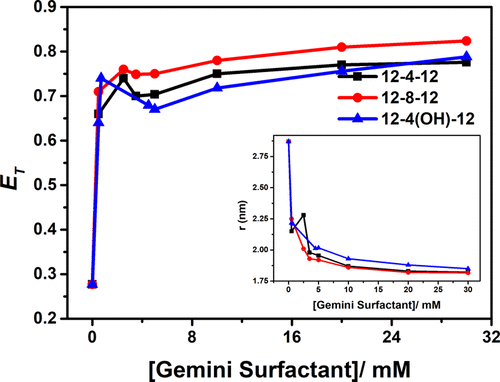Our official English website, www.x-mol.net, welcomes your
feedback! (Note: you will need to create a separate account there.)
Fluorescence Resonance Energy Transfer, Small-Angle Neutron Scattering, and Dynamic Light Scattering Study on Interactions of Gemini Surfactants Having Different Spacer Groups with Protein at Various Regions of Binding Isotherms
ACS Omega ( IF 3.7 ) Pub Date : 2018-09-14 00:00:00 , DOI: 10.1021/acsomega.8b01471 Sayantan Halder 1 , Sunita Kumari 1 , Sugam Kumar 2 , Vinod K. Aswal 2 , Subit K. Saha 1
ACS Omega ( IF 3.7 ) Pub Date : 2018-09-14 00:00:00 , DOI: 10.1021/acsomega.8b01471 Sayantan Halder 1 , Sunita Kumari 1 , Sugam Kumar 2 , Vinod K. Aswal 2 , Subit K. Saha 1
Affiliation

|
The binding interactions of three gemini surfactants having different spacer groups (12-4-12, 12-8-12, and 12-4(OH)-12) with a high concentration (150 μM) of bovine serum albumin (BSA) at various regions of binding isotherms have been studied by means of steady-state fluorescence and fluorescence anisotropy, time-correlated single-photon counting fluorescence of trans-2-[4-(dimethylamino)styryl]benzothiazole, small-angle neutron scattering (SANS), and dynamic light scattering (DLS) measurements. The fluorescence resonance energy transfer phenomenon between the twisted intramolecular charge transfer fluorescent molecule, trans-2-[4-(dimethylamino)styryl]benzothiazole as an acceptor, and tryptophan 213 (Trp-213) of BSA as a donor has been successfully used to probe the binding interactions of gemini surfactants with protein at all regions of binding isotherms. The increasing order of energy transfer efficiency at a higher concentration range of surfactants is 12-8-12 > 12-4-12 > 12-4(OH)-12. Stronger binding of micelles of gemini surfactant molecules having a comparatively more hydrophobic spacer group with the hydrophobic segments of the protein results in closer approach of trans-2-[4-(dimethylamino)styryl]benzothiazole molecules solubilized in micelles to Trp-213. The average excited-state lifetimes become shorter with a trend of increase in contribution from the fast component and decrease in contribution from the slow component to the decay with increasing concentration of a surfactant. The nonradiative rate constant of trans-2-[4-(dimethylamino)styryl]benzothiazole increases with increasing concentration of a surfactant because the average microenvironment around it in protein–surfactant aggregates is more polar as compared to that in native protein. SANS and DLS measurements were carried out for the study of the structural deformations in the protein, on enhancement of the concentration of the gemini surfactants. The necklace and bead model has been used for the analysis of SANS data for the protein–surfactant complexes. At a higher concentration range, 12-8-12 and 12-4-12 have a slightly smaller fractal dimension and a larger correlation length as compared to 12-4(OH)-12. DLS data show that the increasing order of hydrodynamic diameter for the complexes of protein with three gemini surfactants in their high concentration range is 12-4(OH)-12 < 12-4-12 < 12-8-12.
中文翻译:

具有不同间隔基团的双子表面活性剂与蛋白质在结合等温线不同区域的相互作用的荧光共振能量转移,小角中子散射和动态光散射研究
三种具有不同间隔基团(12-4-12、12-8-12和12-4(OH)-12)的双子表面活性剂与高浓度(150μM)牛血清白蛋白(BSA)的结合相互作用通过稳态荧光和荧光各向异性,反式-2- [4-(二甲基氨基)苯乙烯基]苯并噻唑的时间相关单光子计数荧光,小角中子散射(SANS),研究了结合等温线的各个区域以及动态光散射(DLS)测量。扭曲分子内电荷转移荧光分子之间的荧光共振能量转移现象,反式-2- [4-(二甲基氨基)苯乙烯基]苯并噻唑作为受体,BSA的色氨酸213(Trp-213)作为供体已成功用于探测双子表面活性剂与蛋白质在结合等温线的所有区域的结合相互作用。在较高的表面活性剂浓度范围内,能量转移效率的增加顺序为12-8-12> 12-4-12> 12-4(OH)-12。具有相对更多疏水性间隔基团的双子表面活性剂分子的胶束与蛋白质的疏水性部分更强的结合导致更紧密的反式方法-2- [4-(二甲基氨基)苯乙烯基]苯并噻唑分子在微团中增溶成Trp-213。随着表面活性剂浓度的增加,平均激发态寿命随着快速组分的贡献增加而从慢速组分到衰变的贡献减小的趋势而变短。反式的非辐射速率常数-2- [4-(二甲基氨基)苯乙烯基]苯并噻唑随着表面活性剂浓度的增加而增加,这是因为与天然蛋白相比,蛋白质表面活性剂聚集体中周围的平均微环境极性更大。进行了SANS和DLS测量,以研究蛋白质的结构变形,并提高了双子表面活性剂的浓度。项链和珠子模型已用于分析蛋白质-表面活性剂复合物的SANS数据。在较高的浓度范围内,与12-4(OH)-12相比,12-8-12和12-4-12的分形维数较小,相关长度较大。DLS数据显示,在高浓度范围内,蛋白质与三种双子表面活性剂的复合物的流体动力学直径的升序为12-4(OH)-12 <12-4-12 <
更新日期:2018-09-14
中文翻译:

具有不同间隔基团的双子表面活性剂与蛋白质在结合等温线不同区域的相互作用的荧光共振能量转移,小角中子散射和动态光散射研究
三种具有不同间隔基团(12-4-12、12-8-12和12-4(OH)-12)的双子表面活性剂与高浓度(150μM)牛血清白蛋白(BSA)的结合相互作用通过稳态荧光和荧光各向异性,反式-2- [4-(二甲基氨基)苯乙烯基]苯并噻唑的时间相关单光子计数荧光,小角中子散射(SANS),研究了结合等温线的各个区域以及动态光散射(DLS)测量。扭曲分子内电荷转移荧光分子之间的荧光共振能量转移现象,反式-2- [4-(二甲基氨基)苯乙烯基]苯并噻唑作为受体,BSA的色氨酸213(Trp-213)作为供体已成功用于探测双子表面活性剂与蛋白质在结合等温线的所有区域的结合相互作用。在较高的表面活性剂浓度范围内,能量转移效率的增加顺序为12-8-12> 12-4-12> 12-4(OH)-12。具有相对更多疏水性间隔基团的双子表面活性剂分子的胶束与蛋白质的疏水性部分更强的结合导致更紧密的反式方法-2- [4-(二甲基氨基)苯乙烯基]苯并噻唑分子在微团中增溶成Trp-213。随着表面活性剂浓度的增加,平均激发态寿命随着快速组分的贡献增加而从慢速组分到衰变的贡献减小的趋势而变短。反式的非辐射速率常数-2- [4-(二甲基氨基)苯乙烯基]苯并噻唑随着表面活性剂浓度的增加而增加,这是因为与天然蛋白相比,蛋白质表面活性剂聚集体中周围的平均微环境极性更大。进行了SANS和DLS测量,以研究蛋白质的结构变形,并提高了双子表面活性剂的浓度。项链和珠子模型已用于分析蛋白质-表面活性剂复合物的SANS数据。在较高的浓度范围内,与12-4(OH)-12相比,12-8-12和12-4-12的分形维数较小,相关长度较大。DLS数据显示,在高浓度范围内,蛋白质与三种双子表面活性剂的复合物的流体动力学直径的升序为12-4(OH)-12 <12-4-12 <











































 京公网安备 11010802027423号
京公网安备 11010802027423号